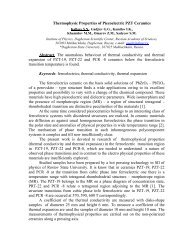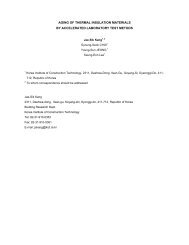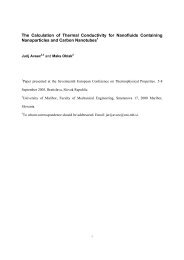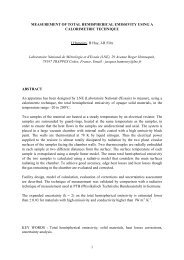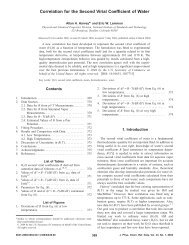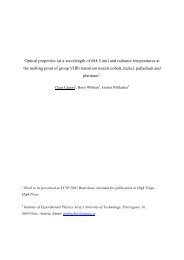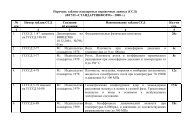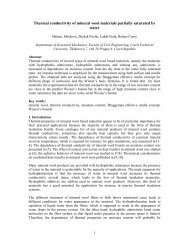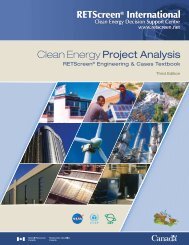Properties of alkali activated aluminosilicate ... - thermophysics.ru
Properties of alkali activated aluminosilicate ... - thermophysics.ru
Properties of alkali activated aluminosilicate ... - thermophysics.ru
You also want an ePaper? Increase the reach of your titles
YUMPU automatically turns print PDFs into web optimized ePapers that Google loves.
The effect <strong>of</strong> high temperatures on mechanical properties <strong>of</strong> <strong>aluminosilicate</strong> materials was<br />
studied in [8] where the compressive strength <strong>of</strong> mortars on the basis <strong>of</strong> <strong>alkali</strong>-<strong>activated</strong> slag<br />
as function <strong>of</strong> heating up to 600 o C was measured. A similar effect on thermal properties was<br />
not yet studied at all. However, the information on the effect <strong>of</strong> high temperatures on the<br />
properties <strong>of</strong> <strong>aluminosilicate</strong> materials might be very useful in practical applications. The high<br />
temperature resistance <strong>of</strong> these materials could be so high that they possibly could survive the<br />
conditions <strong>of</strong> a fire. Then, their properties after thermal load would become a very important<br />
factor because they could be used even after high temperature exposure.<br />
In this paper, compressive and bending strength, thermal conductivity and specific heat<br />
capacity <strong>of</strong> an <strong>alkali</strong> <strong>activated</strong> <strong>aluminosilicate</strong> material are determined on the samples<br />
subjected to thermal load up to 1200 0 C and compared to the reference material data.<br />
2. Materials and samples<br />
Fine-ground slag <strong>of</strong> Czech origin (Kotouč Štramberk, Ltd.) was used for sample preparation.<br />
Its chemical composition is shown in Table 1, its granulometry in Table 2. As <strong>alkali</strong> activator,<br />
water glass solution was used. It was prepared using Portil-A dried sodium silicate preparative<br />
(Cognis Iberia, s.l. Spain). The sand aggregates were normalized according to EN 196-1 with<br />
the granulometry PG1, PG2, PG3. The composition <strong>of</strong> the mixture for sample preparation is<br />
presented in Table 3.<br />
Table 1 Chemical composition <strong>of</strong> applied slag<br />
SiO 2<br />
[%]<br />
Fe 2 O 3<br />
[%]<br />
Al 2 O 3<br />
[%]<br />
CaO<br />
[%]<br />
MgO<br />
[%]<br />
MnO<br />
[%]<br />
Cl-<br />
[%]<br />
Na 2 O<br />
[%]<br />
K 2 O<br />
[%]<br />
38.6 0.52 7.22 38.77 12.90 0.50 0.06 0.21 0.38 0.36<br />
Table 2 Slag granulometry<br />
0.045 mm<br />
[%]<br />
Sieve residue<br />
0.09 mm<br />
[%]<br />
Table 3 Composition <strong>of</strong> mixture for sample preparation<br />
Specific surface<br />
[cm 2 /g]<br />
12.4 1.9 3920<br />
Sand [g]<br />
Slag<br />
[g]<br />
Alkali-activation silicate<br />
admixture<br />
Water<br />
[ml]<br />
PG1 PG2 PG3<br />
[g]<br />
1350 1350 1350 450 90 190<br />
The technology <strong>of</strong> sample preparation was as follows. First, the silicate preparative was mixed<br />
with water. The solution was then mixed in the homogenized slag-sand mixture. The final<br />
mixture was put into 71x71x71 mm molds (for thermal parameters measurement) or<br />
40x40x160 mm molds (for mechanical parameters measurement) and vibrated. The specimens<br />
were demolded after 24 hours and then stored for further 27 days in water bath at laboratory<br />
temperature.<br />
SO 3<br />
[%]<br />
2



